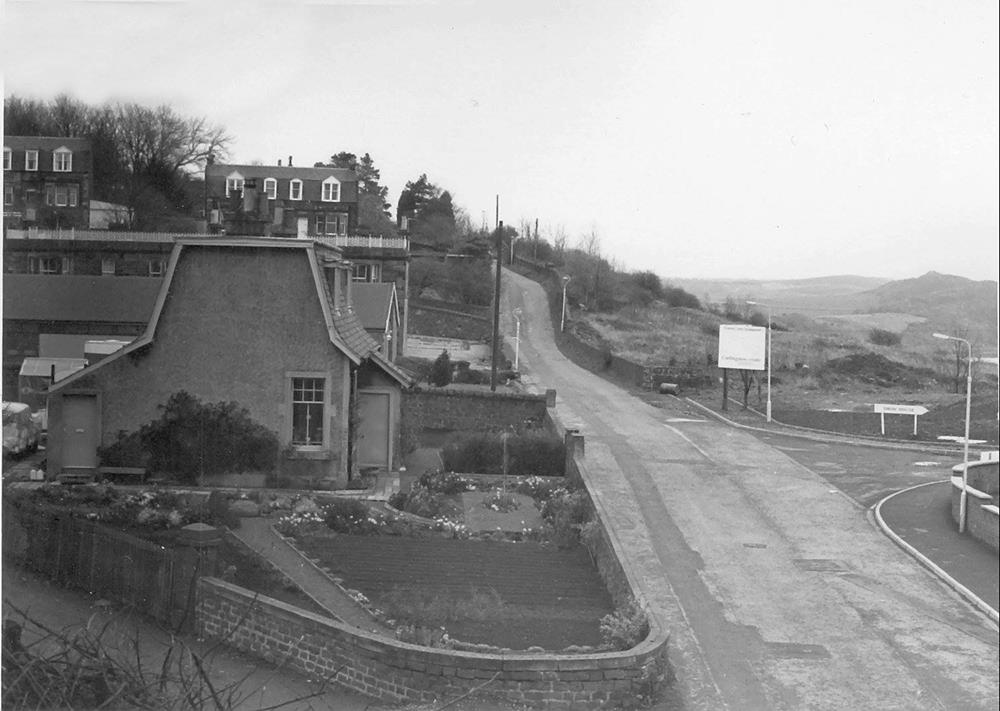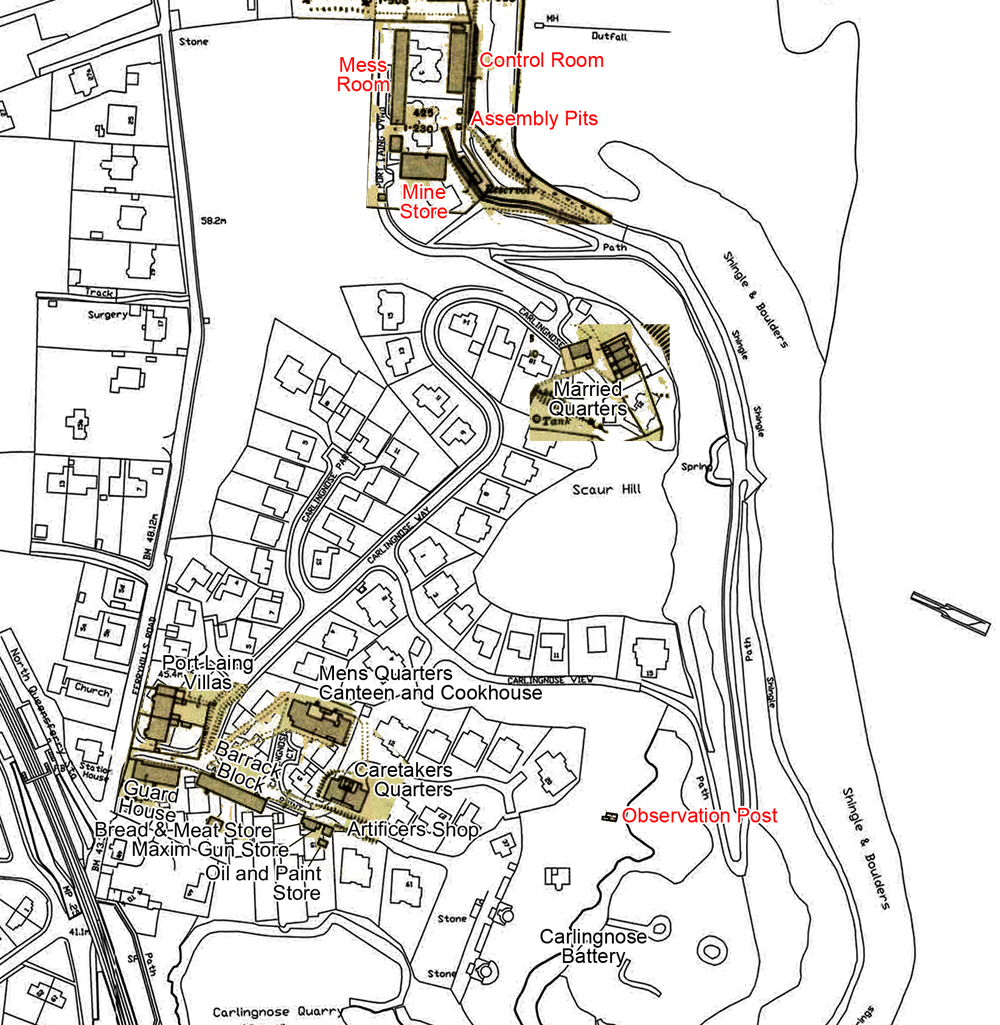Carlingnose Barracks – 1906 to 1960
History
The Carlingnose and Coastguard gun batteries in North Queensferry and on Inchgarvie were manned and maintained by officers and men of the Royal Artillery and Royal Engineers stationed at Carlingnose Barracks.
 Carlingnose Barracks, looking towards Carlingnose Battery. The gun barrels can be seen on the sky-line
Carlingnose Barracks, looking towards Carlingnose Battery. The gun barrels can be seen on the sky-line
The buildings at Port Laing were originally the Submarine Mining Station – Mess Room, Mine Store and Control Room. The station closed in 1906, when the mining service transferred from the Royal Engineers to the Royal Navy.
The buildings were then taken over by the Royal Artillery.

 Submarine Mining Station (red) and Royal Engineer Barracks (blue)
Submarine Mining Station (red) and Royal Engineer Barracks (blue)
World War 1
During World War I there was an increase in manpower on the site, with the need to permanently man the batteries on shore and on the islands plus soldiers to guard the leading the defensive positions around the village . . .
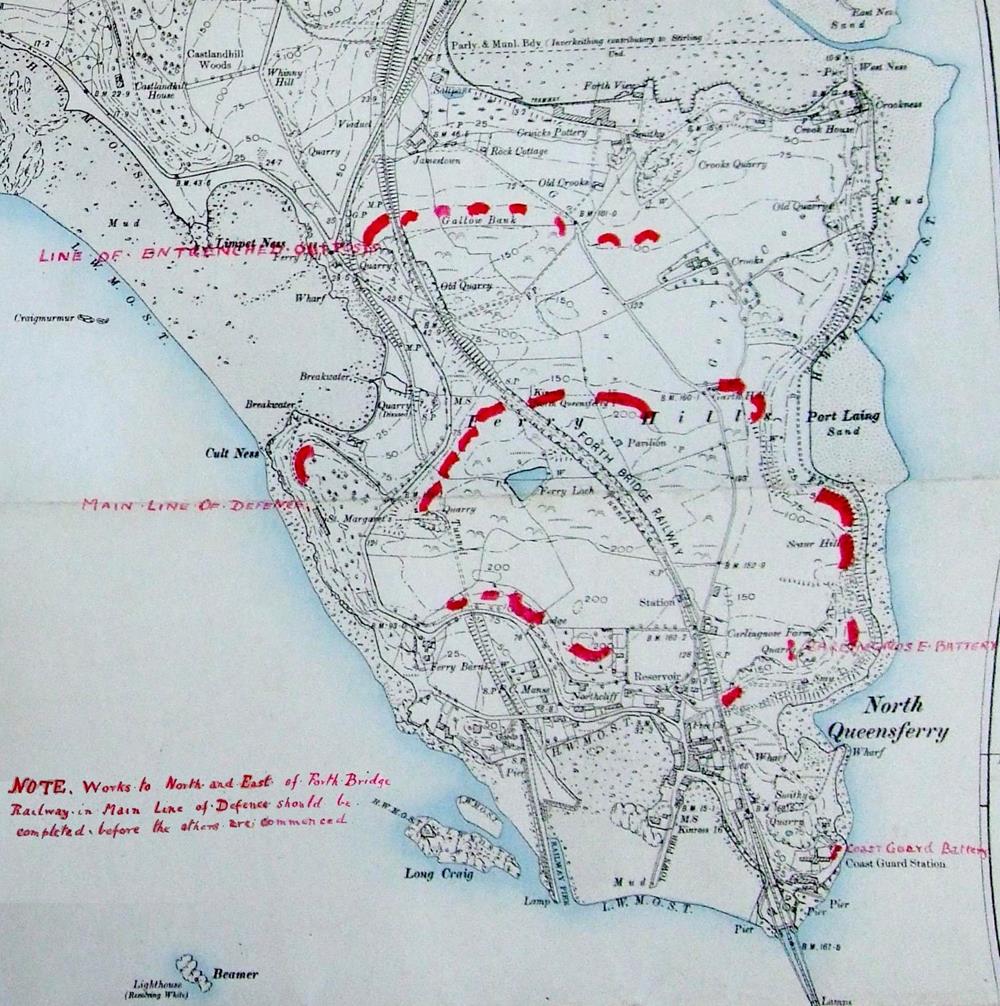 defensive boundaries around North Queensferry
defensive boundaries around North Queensferry
. . . and to man Anti-Aircraft guns – see “Interior of Barracks 17 AA Coy., North Queensferry” for more details.
This led to the erection of wooden huts as temporary accommodation at Carlingnose and on Inchgarvie.
These huts were sold off in 1920 as reported in the Dundee Courier on Saturday June 19, 1920
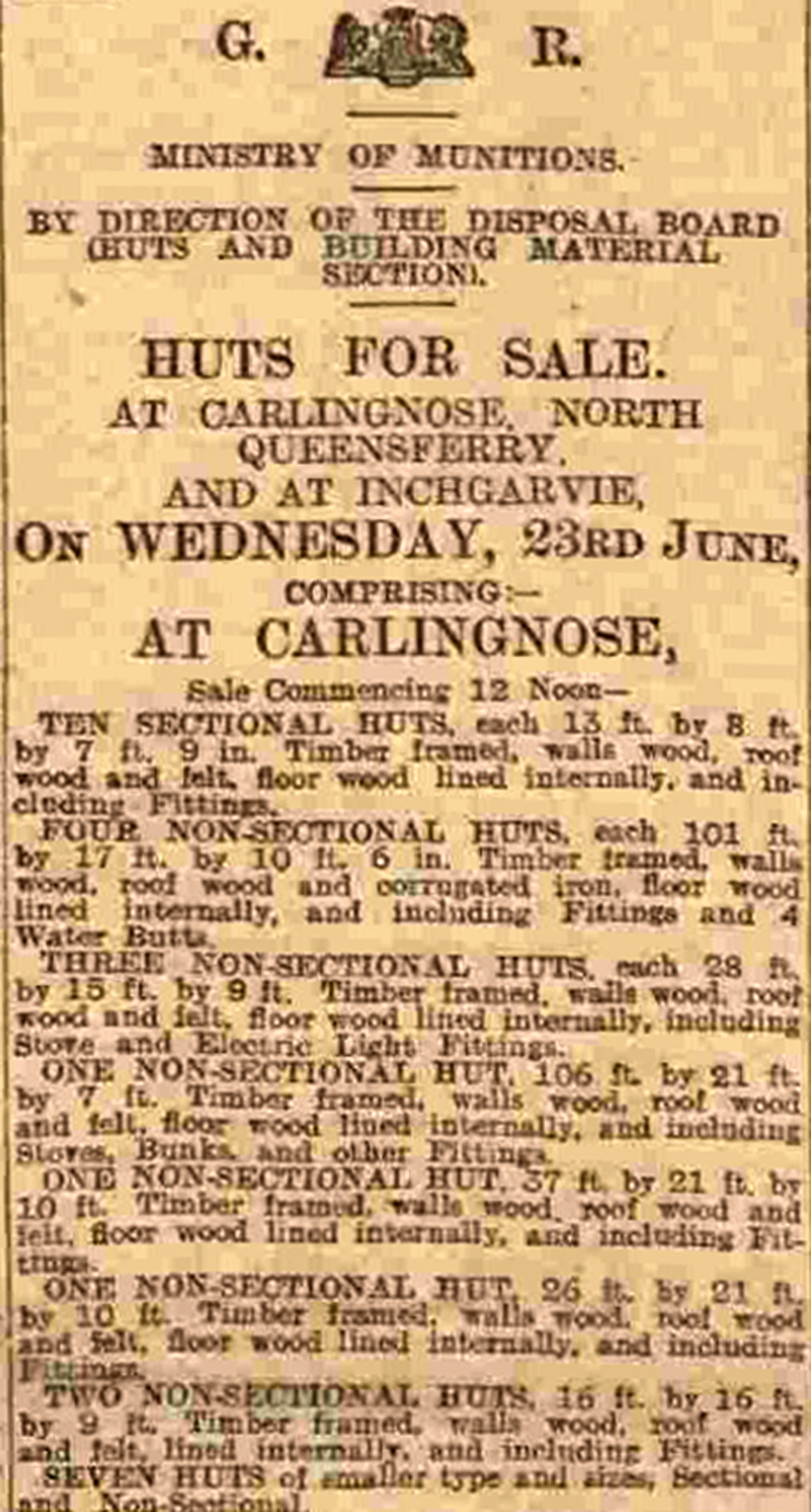
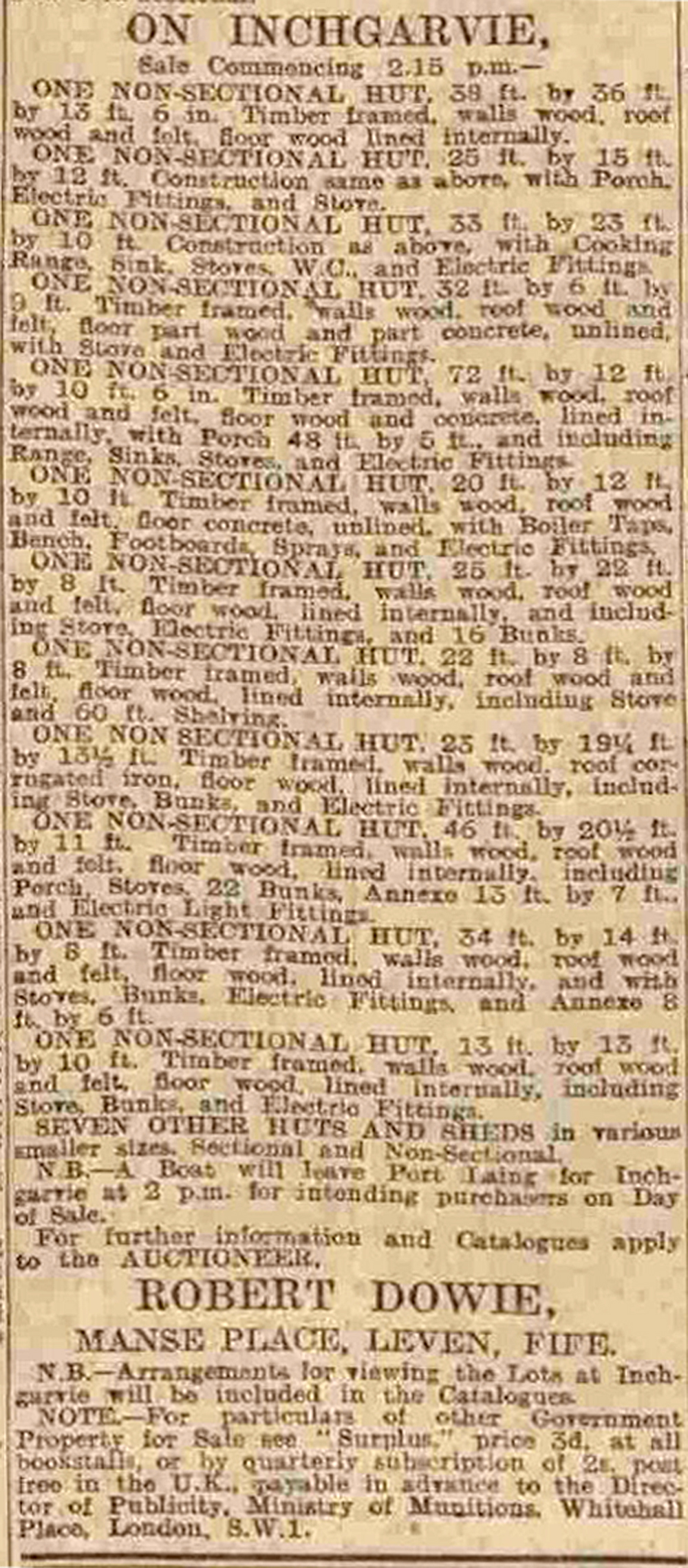
World War 2
Bobbie Banks recollected that in WWII the Royal Army Service Corps (RASC) were based at Port Laing. Ammunition was stored there and transported via the narrow gauge railway to the Gov’y Pier from where RASC vessels carried it to the batteries on the islands.
There were gun batteries on Inchcolm, Inchmickery, Cramond Island, and Inchkeith.
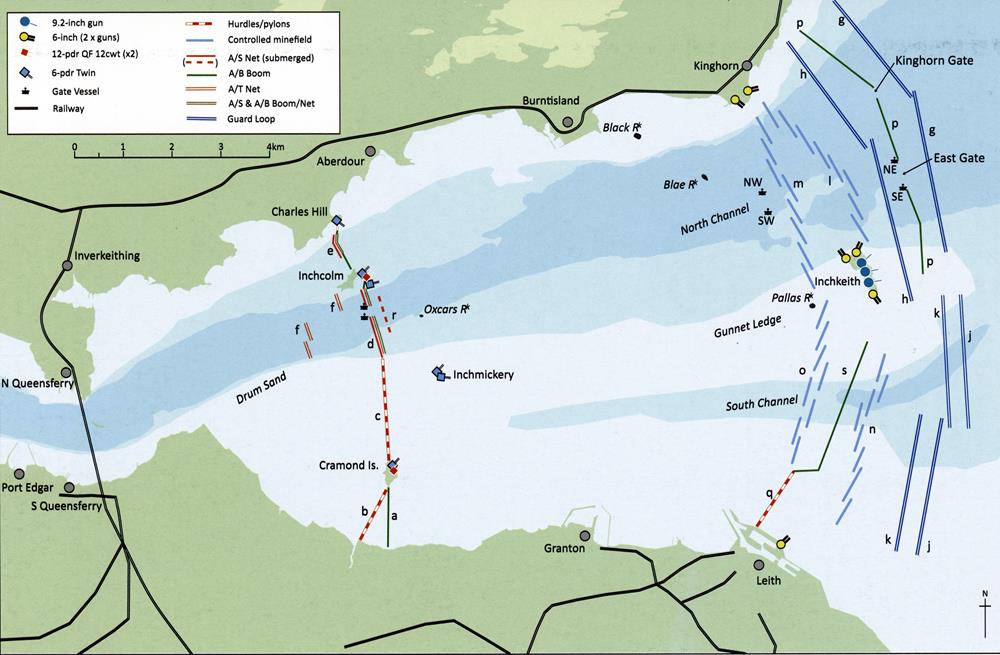 Forth Defences in 1942 showing gun batteries on the islands and shoreline
Forth Defences in 1942 showing gun batteries on the islands and shoreline
Closure of the Barracks
The barracks closed in 1957, and were sold in 1960.
 Carlingnose Barracks, looking from Carlingnose Battery towards the station
Carlingnose Barracks, looking from Carlingnose Battery towards the station
 Carlingnose Barracks from Ferryhills Road
Carlingnose Barracks from Ferryhills Road
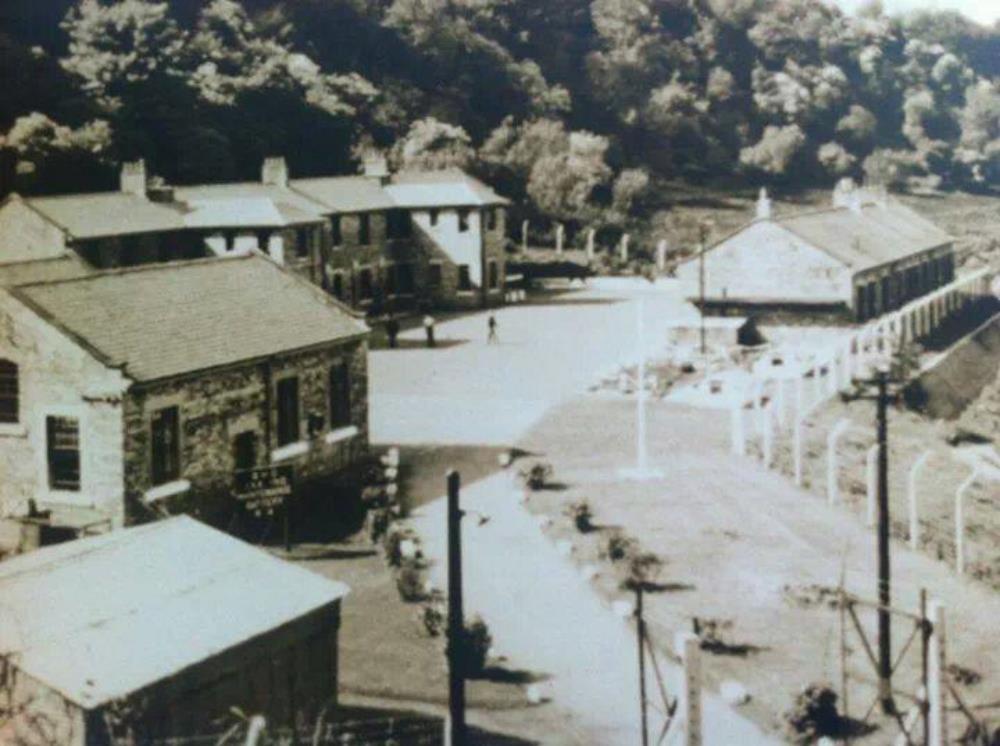 The former Submarine Mining Station buildings at Port Laing
The former Submarine Mining Station buildings at Port Laing
A 56 Gun Salute in 1952
THE COURIER AND ADVERTISER, FRIDAY, FEBRUARY 8, 1952.
 The 268 Maintenance Battery, R.A., from Port Laing, North Queensferry, firing a 56 gun salute at Stirling Castle yesterday, in memory of the King.
The 268 Maintenance Battery, R.A., from Port Laing, North Queensferry, firing a 56 gun salute at Stirling Castle yesterday, in memory of the King.
[King George VI failed to recover from a lung operation, and died in his sleep on 6 February 1952 at Sandringham. Illness had forced him to abandon a proposed Commonwealth tour. Princess Elizabeth, accompanied by Prince Philip, took his place. On Wednesday 6 February 1952, she received the news of her father’s death and her own Accession to the throne while staying in a remote part of Kenya. In an instant, she had ceased to be Princess Elizabeth and became Queen Elizabeth II.
Following the news, the tour was abandoned, and the young Princess flew back to Britain as Queen. She was greeted by Prime Minister Winston Churchill and other officials at the airport before returning to Clarence House. She was officially crowned in a Coronation ceremony at Westminster Abbey the following year, on 2 June 1953.
Her Majesty’s Accession came as she was raising a young family: Prince Charles was three years old and Princess Anne just one when The Queen learnt of her father’s death. Her new duties had to take precedence over family life, with long overseas tours taking her away for months at a time.]
1957 – Last Man Standing
Notes from Laurie Alexander, the last man to leave Port Laing Barracks in 1957.

268 Independent Maintenance Battery,
Royal Artillery,
Port Laing Barracks,
North Queensferry.
(My time there from end of May 1956 to end of March 1957 when it was disbanded.)
CO: Major McCosh
Adj: Capt. Maxham
RA clerks: Sgt John Guthrie – demobbed Autumn 1956 (Orcadian); Laurie Alexander – promoted Bombardier when Guthrie demobbed
Some names remembered
WOII Birse RA
Sgt Laird RAPC
Sgt Fletcher (QM) RA
Sgt Corsar RE or REME
Private Urquhart RE or REME – Home town: Glencorse
Private Souter RE or REME – Home town: Edinburgh
Gnr Johnston RA – Home town: South Queensferry
Gnr Williams RA – Home town: Bridgend, Wales
The function of this unit was the maintenance of coastal heavy gun emplacements.
These were on the following islands in the Firth of Forth: Inchcolm, Inchmickery, Cramond and Inchkeith. On the coast, they were at Kinghorn, Elie, Crail, Broughty Ferry and Nigg. (There may have been some other sites existing at that time.)
There were two RA gunners (privates) on each island and no more than a dozen in the camp. They were more than outnumbered by the REME and RE contingent responsible for the gun emplacements. There were also two cooks from the catering corps.
The unit was gradually run down during the winter months of 1956-7 with the guns being rendered innocuous. Finally tons of HE and armour-piercing shells were removed from the magazines and loaded onto railway wagons for dispersal. I suspect they were dumped in the sea; possibly the Irish Sea.
During the last month of the unit, there was only Major McCosh and myself remaining. The CO had commuted from his home in Edinburgh during my 10 months there, and I was allowed to travel daily from Linlithgow where I lived.
There was not a thing remaining when I finally left the camp.
Laurie provided this sketch of how he remembered the buildings at Port Laing . . .

. . . and this copy of his leave pass

1960 – for sale
The Barracks were put up for sale on Tuesday 30th September 1960
Here is a facsimile of the Carlingnose Sale Booklet

Carlingnose Barracks – some extracts from the Sale Booklet
 LOT C. – BUILDINGS Nos. 12 to 16 – Looking East towards the Fife Coast.
LOT C. – BUILDINGS Nos. 12 to 16 – Looking East towards the Fife Coast.
BUILDING No. 12
Storekeeper’s Quarter. Detached house on 2 floors, brick and harled walls, slated roof.
Ground Floor: Living-room, kitchen with tub and sink. Tru-burn solid fuel cooker with H.W. supply. Bathroom with W.C., W.H.B. and bath.
First Floor: 2 bedrooms with open fires.
BUILDINGS Nos. 13- 16
4 Married Soldiers’ Quarters. Brick and harled walls. Slated roof in terrace, each containing on the ground floor, kitchen with tub and sink. C.I. enamelled bath, separate W.C., Living-room.
On the first floor; one house has I bedroom, one has 3 bedrooms and two have 2 bedrooms. All have modern fires and hot water systems.
 LOT C.-BUILDINGS Nos. 1 to 10.
LOT C.-BUILDINGS Nos. 1 to 10.
PORT LAING AREA-SEASHORE LEVEL
BUILDING No. 1 Two-storied Barrack Block built in brick with slated roof on steel roof trusses containing 4 Barrack Rooms, each 30′ x 18′ approx. and usual offices.
BUILDING No. 2 Blacksmith’s Shop and Moulder’s Shop. Single-storied brick building with slated roof and part concrete roof. Concrete floor-size 24′ x 15′.
BUILDING No. 3 M.T. Garage. Single-storied brick building with slated roof and three bays; 3 double-leaf doors; concrete inspection ramp; concrete floor, overall size 75′ x 40′ approx.
BUILDING No. 4 Metal Store. Wood framed building, clad in weatherboard with corrugated iron roof. Concrete floor. Approx. size 18′ x 15′.
BUILDING No. 5 Petrol Store. Small brick and concrete building. 12′ x 10′.
BUILDING No. 6 Cable Store. Wood framed corrugated Iron Building with brick floor; dilapidated condition.
BUILDING No. 7 Lavatory Accommodation. Containing 4 urinals and 7 W.Cs. Brick built with concrete roof.
BUILDING No. 8 Office and Store Block. Single-storied brick building with slated roof on steel roof trusses and containing 10 rooms with open fires, kitchen premises with two sinks.
BUILDINGS Nos.9 and 10 Pattern Store and Paint Store. Small semi-sunk brick buildings with corrugated iron roof.
NOTE: All the above buildings are contained within a perimeter fence and access is from a tarmacadam road within the main property leading from the main entrance gates.
BUILDING No. 11 Petrol Store. Corrugated iron building; iron-framed; concrete floor; dilapidated state.
Carlingnose Housing Estate
The buildings were demolished and the land gradually became the present-day housing estate.
